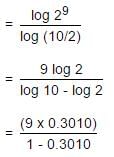CAT Exam > CAT Tests > Quantitative Aptitude (Quant) > Test: Logarithm- 1 - CAT MCQ
Test: Logarithm- 1 - CAT MCQ
Test Description
10 Questions MCQ Test Quantitative Aptitude (Quant) - Test: Logarithm- 1
Test: Logarithm- 1 for CAT 2025 is part of Quantitative Aptitude (Quant) preparation. The Test: Logarithm- 1 questions and answers have been
prepared according to the CAT exam syllabus.The Test: Logarithm- 1 MCQs are made for CAT 2025 Exam. Find important
definitions, questions, notes, meanings, examples, exercises, MCQs and online tests for Test: Logarithm- 1 below.
Solutions of Test: Logarithm- 1 questions in English are available as part of our Quantitative Aptitude (Quant) for CAT & Test: Logarithm- 1 solutions in
Hindi for Quantitative Aptitude (Quant) course. Download more important topics, notes, lectures and mock
test series for CAT Exam by signing up for free. Attempt Test: Logarithm- 1 | 10 questions in 10 minutes | Mock test for CAT preparation | Free important questions MCQ to study Quantitative Aptitude (Quant) for CAT Exam | Download free PDF with solutions
Detailed Solution for Test: Logarithm- 1 - Question 1
Test: Logarithm- 1 - Question 2
If log 2 = 0.3010 and log 3 = 0.4771, the value of log5 512 is:
Detailed Solution for Test: Logarithm- 1 - Question 2
| 1 Crore+ students have signed up on EduRev. Have you? Download the App |
Detailed Solution for Test: Logarithm- 1 - Question 3
Detailed Solution for Test: Logarithm- 1 - Question 4
Detailed Solution for Test: Logarithm- 1 - Question 5
Detailed Solution for Test: Logarithm- 1 - Question 6
Test: Logarithm- 1 - Question 7
If log10 5 + log10 (5x + 1) = log10 (x + 5) + 1, then x is equal to:
Detailed Solution for Test: Logarithm- 1 - Question 7
Detailed Solution for Test: Logarithm- 1 - Question 8
Test: Logarithm- 1 - Question 9
If x and y are positive real numbers such that logx (x2 + 12) = 4 and 3logy x = 1, then x + y equals?
Detailed Solution for Test: Logarithm- 1 - Question 9
Test: Logarithm- 1 - Question 10
For a real number x, are in arithmetic progression, then the common difference is
are in arithmetic progression, then the common difference is
Detailed Solution for Test: Logarithm- 1 - Question 10
|
191 videos|131 docs|110 tests
|
Information about Test: Logarithm- 1 Page
In this test you can find the Exam questions for Test: Logarithm- 1 solved & explained in the simplest way possible.
Besides giving Questions and answers for Test: Logarithm- 1, EduRev gives you an ample number of Online tests for practice
|
191 videos|131 docs|110 tests
|
Download as PDF





 is equal to :
is equal to :
















